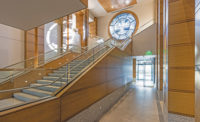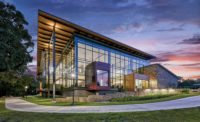Father P. Kashevaroff Library, Archives and Museum
Juneau, Alaska
Best Project
Owner: Alaska Dept. of Transportation and Public Facilities
Lead Design Firm: ECI/Hyer Inc.
General Contractor: PCL Construction Services Inc.
Structural Engineer: Schneider Engineering
MEP Engineer: AMC Engineers
Timing is everything for most projects. But that was especially true for a building designed to house the artifacts of a century-old museum, which ran into trouble early on. Nevertheless, the team overcame the schedule delays to deliver the $102-million project one year before Alaska’s 150-year anniversary.
The Father Andrew P. Kashevaroff Library, Archives and Museum Building is Juneau’s largest project in 43 years.
Construction fell almost two months behind schedule during the project’s first phase due to issues with the post-tensioned concrete floor diaphragm system. To get the work back on track, the team used Lean Construction principles.
Museum executives noticed the change; then they asked PCL Construction Services Inc. to facilitate Lean’s “pull planning” for museum staff tasked with making 2,000 object mounts and coordinating the transfer of 32,000 artifacts.
The building team also exceeded the state’s expectations by completing the facility with a workforce that was 91% Alaskan, says Bob Banghart, deputy director of the state’s division of libraries, archives and museums.
Local expertise was used whenever possible, but, if not, then locals were trained to assist technical experts. The project’s superintendent also regularly visited a construction class at the local high school, and PCL held jobsite construction lectures and tours with University of Alaska Southeast students.
The project’s safety culture also made its mark on the local contracting community, says John Mason, a Juneau-based Occupational Safety and Health Administration inspector. Workers themselves have spread the safety culture to other local projects, he says.
Alaska’s history informed every aspect of the project—the building’s layout reflects the docks formerly on the site.
The main entrance’s terrazzo floor has an inlaid map of Alaska and Russia, while a 35-ft-tall “eagle tree,” a replica of a local fir tree with an eagle nest display, overlooks the main atrium. Copper, a metal that historically represented wealth, was incorporated into the building’s curtain wall.
Related Article: Top Projects Reflect Innovation, Creativity





Post a comment to this article
Report Abusive Comment